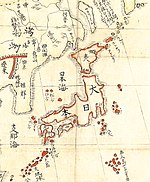Yayoi period - Simple English Wikipedia, the free encyclopedia
| History of Japan |
|---|
 |
The Yayoi period (弥生時代, Yayoi jidai) is a time in the history of Japan which is traditionally dated 300 BC to 300 AD.[1]
History[change | change source]
Early evidence of Yayoi culture is found on the island of Kyūshū. Over time, it spread to the island of Honshū.[2]
Iron and bronze were first used in Japan at about the same time. Iron was used for tools and weapons. Bronze was used for ritual objects such as mirrors, daggers and spears.[3]
The Yayoi tools included as axes and hoes for agriculture etc., but also weapons such as arrowheads and swords.[4]
Yayoi people[change | change source]

The Yayoi people (弥生人 Yayoi jin) were ancient people that migrated to the Japanese archipelago from southeastern China during the Yayoi period (300 BCE–300 CE). Modern Japanese people are direct descedants of the Yayoi and have about 97% Yayoi DNA.[5][6]
The Yayoi and the modern Japanese people are closely related to other East Asian (or Mongoloid) people, such as Chinese or Vietnamese people. They belonged to the haplogroup O and spoke the proto-Japonic languages. Most scientists and linguists suggest that they originated somewhere in southeastern China and migrated from their into Japan.[7][8][9]
References[change | change source]
- ↑ Ancient Cultures, Library of Congress Country Studies, Japan.
- ↑ Nussbaum, Louis-Frédéric. (2005). "Yayoi" in Japan Encyclopedia, pp. 1051-1052.
- ↑ British Museum, Dhoko (ritual spear blade) Archived 2015-10-19 at the Wayback Machine retrieved 2012-2-13.
- ↑ "Neolithic Japan - Yayoi period (c. 250 BC-c. AD 250) - Japanese History Online". yamasa.org. 2004. Archived from the original on 3 March 2016. Retrieved 13 February 2012.
- ↑ Gakuhari, Takashi; Nakagome, Shigeki; Rasmussen, Simon; Allentoft, Morten; Sato, Takehiro; Korneliussen, Thorfinn; Chuinneagáin, Blánaid Ní; Matsumae, Hiromi; Koganebuchi, Kae; Schmidt, Ryan; Mizushima, Souichiro; Kondo, Osamu; Shigehara, Nobuo; Yoneda, Minoru; Kimura, Ryosuke; Ishida, Hajime; Masuyama, Yoshiyuki; Yamada, Yasuhiro; Tajima, Atsushi; Shibata, Hiroki; Toyoda, Atsushi; Tsurumoto, Toshiyuki; Wakebe, Tetsuaki; Shitara, Hiromi; Hanihara, Tsunehiko; Willerslev, Eske; Sikora, Martin; Oota, Hiroki (2019). "Jomon genome sheds light on East Asian population history" (PDF). doi:10.1101/579177. S2CID 92004848.
{{cite journal}}: Cite journal requires|journal=(help) - ↑ "「縄文人」は独自進化したアジアの特異集団だった! : 深読み". 読売新聞オンライン (in Japanese). 2017-12-15. Retrieved 2019-12-19.
- ↑ 崎谷満『DNA・考古・言語の学際研究が示す新・日本列島史』(勉誠出版 2009年)(in Japanese)
- ↑ Robbeets, Martine; Savelyev, Alexander (2017-12-21). Language Dispersal Beyond Farming. John Benjamins Publishing Company. ISBN 978-90-272-6464-0.
- ↑ Vovin, Alexander (2013). "From Koguryo to Tamna: Slowly riding to the South with speakers of Proto-Korean". Korean Linguistics. 15 (2): 222–240.
Other websites[change | change source]
![]() Media related to Yayoi period at Wikimedia Commons
Media related to Yayoi period at Wikimedia Commons
- Metropolitan Museum of Art, Yayoi Culture
- Japan-guide.com, Early Japan


 French
French Deutsch
Deutsch